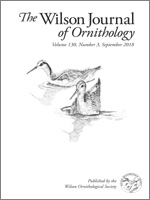One of the least known aspects of the biology of diurnal birds is their nocturnal behavior, which limits our knowledge on their circadian cycles and total home ranges. We studied the nocturnal behavior of the Pale-breasted Thrush (Turdus leucomelas) in a suburban area in Brazil to investigate the relationship between the night roost and diurnal home range (DHR). Birds returned every night to the same roosts in tall trees with dense canopy. In contrast to their nesting habits, birds did not use buildings as nocturnal roosts. In 4 of 9 cases, night roosts were completely outside the DHR. When they were inside the DHR, night roosts were not close to the core area of the DHR. Our results, together with data for a few other bird species, show that considering nocturnal roosting behavior is essential for a more accurate estimate of home ranges of diurnal birds.
How to translate text using browser tools
1 September 2018
Nocturnal roosting behavior of the Pale-breasted Thrush (Turdus leucomelas) and its relation with daytime area of use
André L. B. Moraes,
Natália S. Da Silveira,
Marco A. Pizo
ACCESS THE FULL ARTICLE






